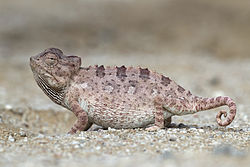Namaqua Chameleon
| Namaqua chameleon | |
|---|---|
 |
|
| Scientific classification | |
| Kingdom: | Animalia |
| Phylum: | Chordata |
| Class: | Reptilia |
| Order: | Squamata |
| Suborder: | Sauria |
| Family: | Chamaeleonidae |
| Genus: | Chamaeleo |
| Species: | C. namaquensis |
| Binomial name | |
|
Chamaeleo namaquensis Smith, 1831 |
|
The Namaqua chameleon (Chamaeleo namaquensis) is a ground-living lizard found in the western desert regions of Namibia, South Africa and southern Angola.
Chamaeleo namaquensis is one of the largest chameleon species in southern Africa, and reaches up to 25 cm in length. Its tail is far shorter than its body and than those of other arboreal species of chameleon. This is an adaptation to its primarily terrestrial habitat. It has large dorsal spines and a prominent, pointed casque on the back of its head, however it lacks the neck flap of other Chamaeleo species. Although capable of changing colour, this chameleon is usually some shade of grey or brown with several lighter patches on the flank, dark patches below the dorsal ridge and yellow or red striping on the throat.
This chameleon species occurs naturally throughout the arid western part of southern Africa, and is particularly common in the Namib Desert. It is recorded as far south as Sutherland, in the Western Cape, South Africa, and as far north as southern Angola. In the furthest eastern edge of its range, in eastern Namibia, it overlaps with the natural range of its relative, the flap-necked chameleon.
Within its natural range, it inhabits arid and semi-arid areas, such as Karoo shrubland, sandy desert and gravel plains. It is terrestrial, and is usually seen walking along the ground.
The Namaqua chameleon has evolved several adaptations to cope with desert conditions: they excrete salt from nasal glands to conserve water, and dig holes to aid in thermoregulation. They also use their ability to change colour to aid in controlling temperature, becoming black in the cooler morning to absorb heat more efficiently, then a lighter grey color to reflect light during the heat of the day — or showing both colours at the same time, neatly separated left from right by the spine.
Unlike the arboreal chameleons of the genus Chamaeleo, its tail is not prehensile, but otherwise it still hunts in the same way, slowly stalking its prey and catching it with its long tongue. Namaqua chameleons feed on insects, (particularly beetles and crickets); lizards, including young chameleons of their own species; small snakes; and even scorpions. They hunt their prey in both sandy dunes and rocky areas.
...
Wikipedia

